Book of Revelation: A New Definitive History of Christian Art in “Ars Sacra”

When Moses came down from the mountain, he carried along stone tablets bearing The Ten Commandments—the definitive law of God. An equally definitive word has been passed down in the form of Ars Sacra: Christian Art and Architecture of the Western World from the Very Beginning Up Until Today, which should instantly assume the role of the definitive guide in words and pictures of Christian art. With 800 oversized pages of high quality photography and insightful text adding up to a mammoth weight of 23 pounds, Ars Sacra wins the heavyweight title of the world of religious art books. All the familiar masterpieces appear with fresh perspectives along with new wonders to behold, making Ars Sacra truly a Book of Revelation for both believers and art-loving nonbelievers.
“Ars Sacra assumes church architecture to be the shell or shrine of Christian art, as Christian art proved independent for the first time in its monumental buildings,” writes publisher and editor Rolf Toman in his introduction. Working from that architectural foundation, Ars Sacra branches out to all genres of Christian art. The focus seamlessly shifts from soaring cathedrals to delicate ivory carvings and gold work of the 9th century Carolingian court. The narrative hums along from panoramic murals to intimate pages from illustrated books such as Book of Kells or Book of Lindisfarne. In addition to working through the genres, Ars Sacra makes sense of the messy periods of Christian history and its artistic expression. “Sacred art from the end of the 18th century until today is characterized by a strong irritation and doubt towards its persuasive powers,” Toman continues. “The efforts of [modern] artists are to give Christ, the True Light of the World, new symbolic expression; they still consider the church interior and its furnishings as a special but also a particularly difficult task.” Ars Sacra unapologetically acknowledges the fading influence of the Christian Church in modern times while simultaneously celebrating the efforts of those artists struggling to keep that “True Light” burning.
As I mentioned earlier, all the familiar landmarks of Christian art appear. Thanks to the “dream team” of commentators assembled by Toman, even those familiar sights seem fresher. Achim Bednorz’s close-up photos of the sculptures and stained glass of Chartes Cathedral make you feel like you’re right there. “Everyone wanted to participate in the construction of these cathedrals,” Bruno Klein writes in the section on the Gothic period, “including those who were interested in the common good or who believed it important that their commitment for the common good become publicly visible.” Coupled with a map of the major Gothic buildings in Europe featuring a close up of the cluster of cathedrals surrounding Paris, Klein’s words and Bednorz’s images combine to give you a feel of what it was like to live in Gothic times, and effect you’ll experience with each new section. Rather than treat them in isolation, Barbara Borngässer studies fresco cycles by Masaccio, Masolino, and Fra Angelico together, thus showing how the church “body” worked in unison through its artists. Even something as familiar as Matthias Grunewald’s Isenheim Altar comes alive again through an extreme full-page zoom on the suffering face and wounded torso of Christ.
For me, Ars Sacra excels even more when it goes off the well-beaten path of art history. Contrasting the grand opulence of places such as Chartes Cathedral, the sparse beauty of less familiar Cistercian Churches of 12th century France strikes with a serene simplicity. “The Cistercian monks do not need pictures to be devoted to their divine love,” Uwe Geese explains in the Romanesque section. “The extensive exclusion of pictures corresponds with the internalization of the emotional and spiritual proximity to God.” Norwegian Stave Churches of the 12th century incorporating Norse legends and Viking building techniques, Protestant Churches of Peace in Poland after the 1648 Peace of Westphalia, and sacred Baroque architecture in South America are just a few examples of the often weird and wonderful revelations of Ars Sacra. It is this diversity that is the true strength of Christianity and Christian art, as well as of Ars Sacra.
The book itself is beautifully made. (You can even see a “making of” video here.) The oversized format allows the photography to render breathtaking wide shots such as the interior of Bernardo Vittone’s dome at St. Chiara at Bra in Italy (shown above) or bring you nose to nose with tiny miracles such as the figures of Ghiberti’s Gates of Paradise. Innovative gatefold designs imitate the action of a 15th century polyptych by Nicolas Froment or a 16th century winged altarpiece by Lucas Cranach the Elder. The sheer size of Ars Sacra requires special handling and a place of prominence in a home or library, but the craftsmanship and content more than earn top honors.
Ars Sacra closes with Gerhard Richter’s window in Cologne Cathedral “generated” by a computer randomizing the arrangement of colors. Richter’s window provides an apt “window” on the uncertain future of the faith itself, which seems more random than rational right now. Looking back, however, Ars Sacra organizes and makes sense of the often disjointed and disorganized history of Christian art spread not only over Europe, but also over most of the rest of the globe. It’s more than a minor miracle of scholarship and devotion to an idea worth putting into print. As this Easter season comes to a close, there may be no better way of knowing what and why you believe than opening and experiencing the book of revelation that is Ars Sacra: Christian Art and Architecture of the Western World from the Very Beginning Up Until Today.
[Image:Bernardo Vittone. St. Chiara at Bra, Italy. 1742. Interior view of dome.]
[Many thanks to H.F. Ullmann for providing me with the image above from and a review copy of Ars Sacra: Christian Art and Architecture of the Western World from the Very Beginning Up Until Today.]





